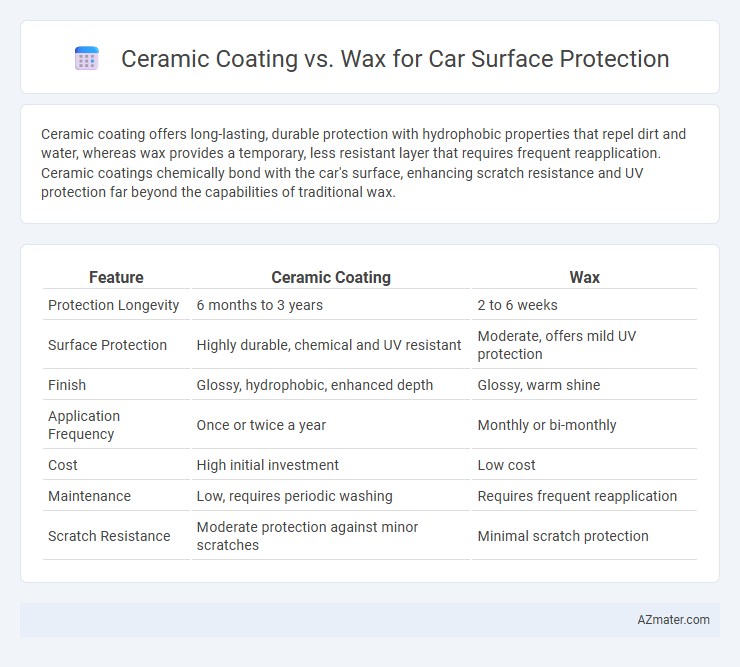Ceramic coating offers long-lasting, durable protection with hydrophobic properties that repel dirt and water, whereas wax provides a temporary, less resistant layer that requires frequent reapplication. Ceramic coatings chemically bond with the car's surface, enhancing scratch resistance and UV protection far beyond the capabilities of traditional wax.
Table of Comparison
| Feature | Ceramic Coating | Wax |
|---|---|---|
| Protection Longevity | 6 months to 3 years | 2 to 6 weeks |
| Surface Protection | Highly durable, chemical and UV resistant | Moderate, offers mild UV protection |
| Finish | Glossy, hydrophobic, enhanced depth | Glossy, warm shine |
| Application Frequency | Once or twice a year | Monthly or bi-monthly |
| Cost | High initial investment | Low cost |
| Maintenance | Low, requires periodic washing | Requires frequent reapplication |
| Scratch Resistance | Moderate protection against minor scratches | Minimal scratch protection |
Introduction to Car Surface Protection
Car surface protection enhances vehicle longevity by preventing damage from environmental elements. Ceramic coating offers a durable, chemical-resistant layer that bonds with the paint, providing long-lasting protection and hydrophobic properties. Wax creates a temporary barrier that enhances shine but requires frequent reapplication due to its limited durability.
What is Ceramic Coating?
Ceramic coating is a liquid polymer applied to a car's exterior that chemically bonds with the factory paint, creating a durable, hydrophobic layer. This advanced protection enhances gloss, resists environmental contaminants like UV rays, bird droppings, and dirt, and significantly reduces the need for frequent waxing. Unlike traditional wax, ceramic coatings offer long-lasting durability, often protecting the vehicle for years rather than weeks.
What is Car Wax?
Car wax is a traditional protective layer made from natural or synthetic ingredients designed to enhance shine and provide a temporary barrier against dirt, UV rays, and moisture. It typically lasts a few weeks to months, requiring frequent reapplication to maintain protection and gloss. Unlike ceramic coating, car wax does not offer long-term durability or resistance to scratches and harsh environmental contaminants.
Key Differences Between Ceramic Coating and Wax
Ceramic coating forms a durable, chemically resistant layer that provides long-lasting protection against UV rays, dirt, and minor scratches, whereas wax creates a temporary barrier that requires frequent reapplication. Ceramic coatings offer enhanced hydrophobic properties and superior gloss retention, improving the car's visual appeal over time compared to the traditional wax finish. While wax is more affordable and easier to apply, ceramic coatings deliver greater durability and protection ideal for maintaining a pristine car surface.
Application Process: Ceramic Coating vs Wax
Ceramic coating requires a thorough surface preparation including cleaning, claying, and sometimes paint correction before application, which demands professional skill for optimal results and durability lasting up to several years. Wax application is simpler and faster, involving only cleaning followed by manual or machine buffing, offering temporary protection that typically lasts a few weeks to months. The complexity and longevity of ceramic coatings make them suitable for long-term protection, whereas wax is ideal for quick, cost-effective surface shine and hydrophobic properties.
Durability and Longevity Comparison
Ceramic coating provides superior durability compared to traditional wax, lasting up to 2-5 years with proper maintenance, while wax typically wears off within a few months. The advanced polymer bonds of ceramic coatings create a hardened layer that resists UV rays, oxidation, and chemical stains more effectively than the softer, natural ingredients found in waxes. This enhanced longevity of ceramic coatings reduces the frequency of reapplication, offering more consistent protection and preserving the car's paintwork for an extended period.
Protection Against Environmental Elements
Ceramic coating provides superior protection against environmental elements such as UV rays, acid rain, and bird droppings due to its durable, hydrophobic layer that resists chemical etching and oxidation. Wax offers a temporary barrier, but it deteriorates quickly under harsh conditions, requiring frequent reapplication to maintain protection. The advanced nanotechnology in ceramic coatings forms a long-lasting shield that preserves automotive paint quality far better than traditional wax.
Maintenance Requirements for Each Option
Ceramic coating offers long-lasting protection with minimal maintenance, requiring periodic washing using pH-neutral car shampoos to preserve its hydrophobic properties and prevent surface contaminants. Wax demands frequent reapplication, often every 4-6 weeks, to maintain its protective layer against UV rays, water spots, and dirt buildup, making it more labor-intensive. The advanced durability of ceramic coatings reduces the need for polishing and waxing, improving overall vehicle appearance and reducing upkeep costs over time.
Cost Analysis: Ceramic Coating vs Wax
Ceramic coating offers long-term cost savings despite its higher initial price, with professional applications ranging from $500 to $2,000 compared to wax treatments costing between $20 and $60 per application. Wax requires frequent reapplication, typically every 1 to 3 months, leading to higher cumulative costs over time, while ceramic coatings provide durable protection lasting 2 to 5 years or more. Factoring in labor and material expenses, ceramic coating is more cost-effective for vehicle owners seeking prolonged surface protection and reduced maintenance frequency.
Which is Best for Your Car?
Ceramic coating offers superior durability and long-term protection compared to traditional car wax, providing a hydrophobic layer that repels dirt, water, and UV rays for up to five years. While wax enhances shine and is cost-effective with easy application, it typically lasts only a few weeks to months and requires frequent reapplication. For optimal car surface protection, ceramic coating is best suited for those seeking a lasting, high-performance finish, whereas wax remains ideal for budget-conscious owners desiring quick, temporary enhancement.

Infographic: Ceramic coating vs Wax for Car surface protection
 azmater.com
azmater.com